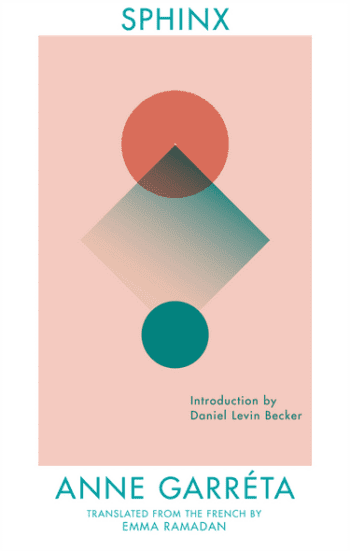
Sphinx by Anne Garréta is a slender novel that tells the tale of two lovers in Paris. Its setting is not the literary Paris that comes to mind: cafes filled with artists and intellectuals, evening strolls through wide boulevards. Sphinx takes place in afterhours clubs and cabarets—the underbelly of Paris. This is a love story between DJ and dancer, between the narrator and A***.
Although Sphinx was written prior to Garréta joining the Oulipo, it nevertheless exhibits their approach to writing. Raymond Queneau, founding member of the Oulipo, famously described the group as “Rats who build their own labyrinth from which they try to escape.” Oulipian constraints typically operate on linguistic aspects of writing and result in a kind of linguistic play. At worst, these constraints are merely a word game, absent of any meaning. At best, they reinvigorate literature as a mode of expression through innovative formal techniques that advance themes of the work. For example, Georges Perec’s La Disparition, a novel-length lipogram that doesn’t use the letter E, reflects on themes of loss and incompleteness.
The constraint Garréta uses in Sphinx is notable because it is rooted foremost in semantics, which has specific linguistic consequences. Garréta purposely omits any mention of either lover’s gender. This presented certain difficulties for the translator, Emma Ramadan. She sums it up best when she writes, “In French, the subject’s gender can be identified as soon as there is agreement with a verb in the past tense or with an adjective, whereas in English the subject’s gender can only be identified through personal pronouns and possessive adjectives.” Garréta does not use any pronouns (she/he) or possessive pronouns (her/his) that would indicate the gender of either A*** or the narrator. Instead, they are identified by name or body part (body parts are gendered in French, but not indicative of sex).
To write a genderless narrative is inherently a political act, and Sphinx is born from the experiences of marginalized subjects who are constrained in everyday life by social norms. But Garréta manages to avoid participating in a politics of identity by eliminating gender altogether rather than trying to represent the experience of a specific marginalized subject.
Writing from the unconscious is characteristic of Surrealist “automatic” writing; the Oulipo have tended to avoid it. But Sphinx dances between unconscious and conscious modes of narration. The majority of the narrator’s actions are habitual—contemplating bodies, clubbing, reading. This is partly a consequence of Garréta’s use of the imperfect tense; in French, the imperfect tense is not necessarily marked by gender, unlike most tenses, so it’s perfect for Garréta’s purposes. As a result, the sequence of events becomes muddled and fragmented. The narrator frequently acknowledges this, “My memory of all this is broken, incomplete. All those nights ended up melting into one, jerky and repetitive like the music.” However, the fragments that do surface from this unconscious reservoir are vividly and eloquently incarnated. This is particularly true of the prose around lights, music, and bodies—the primary elements that compose nightclubs. They are rendered in rapturous tones: “a sweltering, vitrified clash of light and flesh in the swaying red darkened with so many lights that there was neither dusk nor dawn.” And: “I was in a coma agitated by rhythms that were more and more painfully arousing my desire without ever draining it.” I could go on—exquisite fragments like these are packaged in nearly every page.

Without gender operating as a signifier of identity, Garréta can give greater attention to bodies. Indeed, this is how the narrator meets A***: “So I must have first spotted A*** during a melancholic, disinterested contemplation of a succession of bodies I wasn’t trying hard to distinguish.” Garréta’s feverish descriptions of A*** are even more enticing than her descriptions of dancing in clubs. She has us stroking the page as if it were skin, fingering its edges, ready to turn and continue reading.
A*** crossing the stage in the feline roving of the choreography, embodying an enigmatic, silent figure twisting to the extreme limit of dislocation in miraculous movements that were syncopated but not staccato. Even as this body fades away a spectral figure remains, immobile; the stage is populated with incarnations, sudden gestures, hieratic poses set in a relentless progression. There was something cat-like or divine in this body that, moved by some sly, sensual pleasure, was embodying in nonchalant strides a languid damnation, an immemorial fatality made into movement.
Bodies are reflected, massed, fragmented, “spectral.” The narrator idealizes A*** to the extent that A*** becomes a mere surface onto which the narrator projects a fantasy. “I watched A***’s body mutate into an image.” And then there’s the assemblage of bodies on the dance floor, “The numerous innumerable bodies made up a monster of a hundred heads and tangled limbs whose only cohesion and life force came from the rhythmic impulse I dealt to it.” Perhaps these bodies are made all the more lucid precisely because of their mutations.
The imagery of assemblage and A***’s “cat-like” body allude to the title, Sphinx. The sphinx is a combination of various parts of a lion, human, and sometimes bird, whose sex varies in different mythologies. The sphinx posed a riddle to Oedipus: What walks on four legs, then two, then three? Oedipus answered correctly: Man. In doing so, he failed to recognize women. This failure to recognize women turned fatal when Oedipus, unable to recognize his own mother, married her. Garréta plays off Oedipus’ misrecognition of women by refusing to recognize gender altogether in the case of the narrator and A***.
When I set aside the constraint and the texture of the prose and look at the plot of Sphinx, I shrug. The narrative arc and the main characters are all too familiar. Love at first sight, a drawn out courtship, a tragic end. And yes, opposites do attract. Perhaps Garétta omits gender to show it is inessential to such narratives. The frustration of trying and failing to detect the gender of A*** and the narrator would appear to indicate the success of Garétta’s constraint. Nevetheless, Garréta would have written a better book, and a better Oulipian book, if she had not used these binary tropes—opposites attract, symmetrical narrative arcs, black “soul” and white puritanism. Had she tried instead to abandon these patterns and forms, to dissolve these restrictive molds in favor of new or hybrid genres, the book would be more compelling.
Sphinx illustrates the political potential of Oulipian constraints. The Oulipo have typically withdrawn from politics in favor of contemplating new literary forms. But, as Garréta eloquently demonstrates, to engage in political writing does not come at the expense of literary merit. In fact, the political constraint in Sphinx deeply enriches the text. The Oulipo should expand their interest in potential forms of literature to include potential uses of literature. Sphinx is a decisive and welcome move in this direction.




